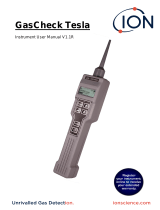Page is loading ...

87-900-073-01(B)
April 18
th
, 2011
PHD-4 capillary leak
Model 969-3540
1. GENERAL
The Agilent PHD-4 capillary leak model no. 969-3540
has been designed to allow a fast, simple and effective
way to check the calibration of the Agilent HPD-4 leak
detector.
The PHD-4 capillary leak contains a crimped stainless
steel capillary to regulate the helium flow. The leak
element is attached to a 110 cc stainless steel reservoir
with an adapter that mates with the PHD-4 probe.
The reservoir has a pressure gauge for adjusting the
driving pressure behind the capillary leak element in
order to change the helium flow rate. The gauge
measures the pressure up to 11 bar (160 psig).
The calibration is obtained by comparing the Helium
concentration generated by the capillary leak in the
provided calibration chamber with the actual reading of
PHD-4 and correcting this one if necessary.
The value of the Helium concentration is of the
order of 100 ppm (for a reservoir pressure of 100
PSI, 7 bar), and is specified in the calibration curve
supplied with each unit.
NOTE
The supplied calibration curves are valid for PHD-4
devices equipped with the standard length probe.
2. DESCRIPTION
The PHD-4 capillary leak package is shown in
figure 1;
it includes the following parts:
1) PHD-4 capillary leak;
2) Nylon bag containing O-ring Parker 2-120 BUNA
(2 pcs.);
3) Instruction manual.
Figure1
INSTRUCTIONS
Agilent Technologies Inc.
121 Hartwell Avenue, Lexington, MA 02173, USA
Agilent Technologies Italia S.p.A.
Via F.lli Varian, 54 - 10040 Leinì (TO) - Italy

The PHD-4 capillary leak consists of the following main parts (see figure 2):
1) Capillary leak;
2) Rechargeable Helium reservoir;
3) Pressure gauge (from 0 to 11 bar/160 psi);
4) Helium recharging valve (connections: Gc 1/4).
5) Calibration curves
6) Calibration chamber
7) O-ring
3. OPERATION
The calibration is done according to the following
steps:
1) First of all, move the PHD-4 and probe away
from Helium sources;
2) Set the unit to Fixed Zero operation;
3) Check the zero level;
4) Press simultaneously the SENS and MODE
pushbuttons for more than 2 seconds;
5) Insert the PHD-4 probe in the calibration
chamber (see figure 3); the display show:
- - > C a l i b r a t i o n
P L E A S E W A I T *
and after a few seconds the display will be as show:
. . . . . . . . .
0
< - C A L - > *
6) Read on the capillary leak gauge the actual
Helium pressure in the bottle;
7) Using the pressure/concentration curve
(attached to the Helium bottle neck), determine
the actual concentration value in ppm;
N.B.: Use the pressure/concentration curve plotted
for your PHD-4 typology.
8) Pressing SENS (down button) or MODE (up
button) pushbuttons, correct PHD-4 reading as
necessary;
9) Press the SENS and MODE pushbutton
simultaneously to exit the calibration routine and
memorize the new setting.
For any other information about the Calibration
procedure refer to the PHD-4 instruction manual,
Section IV, §4-2.
NOTE
The PHD-4 capillary leak is shipped with the
reservoir filled with helium at low pressure. To
operate it, a helium refilling should be performed,
according to paragraph 4.
Figure 2
87-900-073-01(B) PHD-4 capillary leak Page 2/3

4. REFILLING THE HELIUM RESERVOIR
When the reservoir pressure goes down to
approx 30psi (2 bar), the capillary leak needs to
be refilled with pure Helium.
Refilling steps:
1) Attach a clean line from pure helium bottle to
the fill valve of the leak, but do not tighten
the connection;
2) Flow helium through the line to purge the
remaining air from the line;
3) Tighten the connection to the valve;
4) Open the fill valve;
5) Fill the leak to 11 bar (160 psig);
6) Loosen the connection from the helium
source;
7) Open the fill valve and vent the leak to 2 bar
(approximately 30 psig);
8) Repeat steps 3-7 three times to assure gas
purity;
9) Fill to the pressure indicated on the label to
obtain the desired flow rate.
To avoid clogging of the capillary, the line from
your helium source must be clean and free of
moisture. Copper or stainless steel lines are
recommended. A rubber hose should NOT
be
used.
5. STORAGE
Capillary leaks are subjected to clogging and
must be kept clean and dry. Store in an air-tight
container when not in use. Care should be
takenthat the end of the capillary tube is not
exposed to oil and dirt.
Recalibration of the gauge is recommended on
an annual or biannual basis depending on the
severity of the environment in which the leak is
being used.
DISPOSAL
Meaning of the "WEEE" logo found in labels
The following symbol is applied in accordance with
the EC WEEE (Waste Electrical and Electronic
Equipment) Directive.
This symbol (valid only in countries of the
European Community) indicates that the product it
applies to must NOT be disposed of together with
ordinary domestic or industrial waste but must be
sent to a differentiated waste collection system.
The end user is therefore invited to contact the
supplier of the device, whether the Parent Company
or a retailer, to initiate the collection and disposal
process after checking the contractual terms and
conditions of sale.
CAUTION

87-900-073-01(B) PHD-4 capillary leak Page 3/3
/


